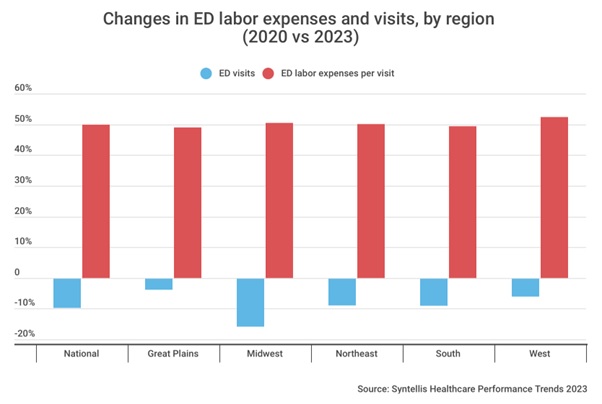Healthcare Layoffs Stats 2023

2022 has been a devastating financial year for nearly every working sector and the healthcare sector is not immune to this phenomenon. Layoffs in the United States have gone up by a whopping 287% from May 2021 and healthcare, an industry known for its stability, is also witnessing aftershocks of the Covid led economic crisis.
In just the first five months of 2023, the healthcare sector including healthcare institutions and healthcare product manufacturers, have announced over 33,000 layoffs. This number is up by 81% from May 2022 when a little over 18,000 layoffs were announced. Read on to know more about the healthcare layoffs in 2023, its reasons and how this crisis can be resolved.
Layoffs in healthcare can occur due to various factors such as organizational restructuring, financial challenges, staff shortage and changes in healthcare policies. According to a report published by Syntellis, hospitals in the United States saw a rise in year-on-year (YoY) margins in January by 3.7 percentage points. This is the first instance since the YoY increase in December 2021. Hospitals also witnessed an increase in gross operating revenue by 10.1% YoY. The increase can be attributed to an increase in outpatient revenue which went up by 18.7%.
Emergency department (ED) labor expenses have gone up by at least 50% since the beginning of the COVID-19 pandemic back in 2020. However, the number of ED personnel has steadily declined over the past three years. Healthcare institutions in the Western States of USA have reported a 52.4% increase in ED labor expenses between January 2020 and January 2023. These expenses have been attributed to the average increase in wages of registered nurses. Western States, especially California, have the highest average for hourly wages of registered nurses at $64 in 2023.
The acute shortage in nursing staff has led to healthcare institutions heavily relying on contractual nursing staff. As a result, healthcare institutions are also witnessing a surge in contractual labor expenses. The American Hospital Association has reported that contract labor expenses have increased by at least 258% between 2019 and 2022. The average wage paid to contractual healthcare employees has gone up by 57%. If measures are not taken to resolve the nursing shortage crisis, the cost for contractual healthcare services will continue to surge in 2023. As per experts at Syntellis, this year will continue to see an increase in expenses due to nurse shortage and continued reliance on contractual staff. Nurse shortage is a serious crisis in the American healthcare landscape.
Click here to know more about the nursing shortage in USA
In a bid to reduce costs, healthcare institutions are laying off hundreds and thousands of employees. However, most of the cutbacks are happening in the administrative departments of healthcare institutions. Nonclinical employees are bearing the brunt of the high cost of patient facing employees and healthcare institutions, big or small, are laying off employees in the administrative departments.
Here are some of the most prominent examples.
- Between February and April 2023, Adventist Health laid off 59 administrative employees citing reorganization of staff to consolidate its care networks – this move saved them nearly $100 million in expenses.
- Cedars-Sinai Medical Center reportedly laid off 131 non-union employees at its main facility and about two dozen more employees at other locations. These employees were a part of non-patient care departments including administrative support, pharmacy technicians and hospital operations management.
- Employees at Compass Health were caught off guard when the healthcare institution announced a layoff of at least 500 support staff last year.
- Crozer Health fired 215 employees that made up 4% of their total workforce. They cited the reason for the layoff as restructuring in a bid to cut costs and optimize administrative efforts. This move also included shutting the door on any underutilized health services.
- Madera Community Hospital, which reported running at a $2.5 million per month operational deficit, let go an alarming 772 permanent employees in January.
- McClaren’s Healthcare laid off 743 employees, a third of which were registered nurses. Other laid off employees included nursing assistants, pharmacists, accountants, housekeepers, physical therapists and technicians. It also included the healthcare institution’s chief operating officer and vice president of patient care services and the chief nursing officer.
Hospital expenses, particularly for labor, continue to be high amid growing inflation and persistent staff shortages ultimately resulting in revenue deficit. In a bid to cut costs, healthcare institutions are reorganizing and optimizing their current resources. As a result, employees in non-patient facing roles as well as patient facing roles are facing severe consequences.
One way to resolve layoffs will be to resolve the nurse shortage crisis. Healthcare institutions urgently need to go back to the drawing board and recalibrate their workforce management strategies. Addressing the shortage of nursing staff is critical because experts are predicting an upward trajectory for the shortage that can lead to a large-scale healthcare staff emergency by 2030.
Here are some ways to reduce nurse shortage
Offer nurse exchange and out of State on the job training programs
Affiliated healthcare institutions need to start offering out of state and on the job nurse training programs or even nurse exchange educational programs. This will fill a significant amount of available nursing positions in States that are facing a shortage and even reduce the amount of nurses in States that are experiencing a surplus. Additionally, State funded teaching hospitals (especially those in States that are likely to experience severe deficit) can increase their intake of students wishing to train in the medical care field.
Reduce the burden on hospital staff to eliminate burnout
According to the New England Journal of Medicine, 50% of healthcare workers report symptoms of burnout and decreased morale. This is because healthcare institutions are expecting to extract more work from lower numbers of manpower. This burnout rate is expected to continue increasing as the urgent need for healthcare professionals continues to increase. By employing technology based solutions like machine learning software for patient care management – healthcare institutions can considerably reduce the burden on nursing staff.
Using AI-based recruitment solutions for healthcare recruiting
By using AI-based recruitment solutions, recruiters can significantly cut down the time taken to hire medical professionals. AI-based solutions can easily post information about job availability, shortlist and categorize applications, conduct skill assessments and even schedule interviews. These solutions not only save time, they also eliminate recruiter bias. The advanced AI in Arya is revolutionizing the healthcare recruiting industry by using 300+ parameters and 7 multi-dimensional data points to score and rank talent for compatibility. Arya simultaneously helps source candidates from multiple channels in under 5 minutes, reducing candidate review and shortlisting time by 50%. Request a Demo to understand how Arya can help your organization streamline its healthcare staffing challenges in time to avoid a nursing shortage crisis.
Over To You
1 in 3 nurses are likely to quit their job in the next five years as per a report by USA Today. The United States National Council of State Boards of Nursing stated in a report that about 100,000 registered nurses have left the profession since 2020. If they don’t leave, they also run the risk of getting fired. Additionally, increasing wages for nursing staff means other non-patient staff bear the brunt of cost cutting. Eventually, the administrative work is expected to be taken on by nursing staff – leading to burnout and continuation of the vicious cycle.
Resources
- https://www.challengergray.com/blog/may-2023-layoffs-jump-on-tech-retail-auto-ytd-hiring-lowest-since-2016/
- https://www.syntellis.com/sites/default/files/2023-03/Performance%20Trends%20Feb_HC.1102.03.23.pdf
- https://www.advisory.com/daily-briefing/2023/03/13/hospital-expenses






